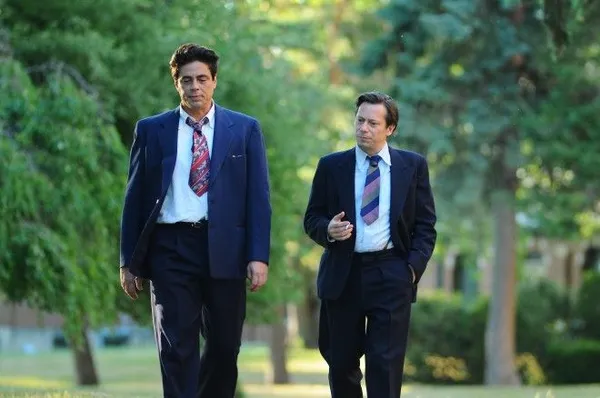 |
| Jimmy P and Georges Devereux: "And to be in Topeka, Kansas which is nothing, the most boring place in the world." |
In Part 1 of my conversation with Arnaud Desplechin on Jimmy P: Psychotherapy Of A Plains Indian, Jimmy Stewart began the masculine thread. Here the director sheds light on Mathieu Amalric's approach to his character Georges Devereux and how it differed from Benicio Del Toro's with Jimmy P.
We discussed how widowers, Gary Cooper's Doc Frail in The Hanging Tree and Henry Fonda's Young Mr. Lincoln, can give a "Thomas Hardy kind of feeling", and the ties Kings and Queen with Emmanuelle Devos, Catherine Deneuve, and Amalric has to Jimmy P.
Arnaud Desplechin arrived to meet me for our conversation with his star Mathieu Amalric and the current and former New York Film Festival Directors Kent Jones and Richard Peña.
Anne-Katrin Titze: When I spoke with Mathieu [Amalric] earlier, he wanted to take no credit and kept pointing at you, saying you were responsible for his great performance. He said "I am the witness." Actor as witness is an interesting concept, no?
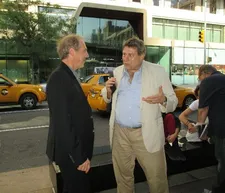 |
| Arnaud Desplechin with former New York Film Festival Director Richard Peña. Photo: Anne-Katrin Titze |
Arnaud Desplechin: What I think Mathieu was trying to articulate was the fact that you have two traditions of acting. The work Benicio [Del Toro] did was amazing; he is such a hard worker. About the migraines… he knew the book [the case study Reality And Dream by ethnologist and psychoanalyst Devereux] by heart. He knew everything in the book, it was amazing. But Mathieu - I remember I had some DVDs of Devereux from French TV - Mathieu didn't want to look at them. He said to me "I don't want to be Devereux, I want to be your Devereux." A different kind of acting, the French kind of acting, you know.
AKT: One of the first images in your movie cast a spell on me. Sunlight flickering in the white lace curtains. But what kind of a spell is it? You don't really know if it is magic or
AD [interrupts me]: A curse? A nightmare. Yes.
AKT: Then the magic disappears and the film turns towards other matters. After the cows in the forest.
AD: I loved opening the film like a magic piece. The cows in the trees. It is such a dream-like image. Actually it was a nightmare to achieve that. I love starting with magic. At the beginning of Kings and Queen you see Emmanuelle Devos arriving at this shop and she was finding this engraving of Leda.
AKT: With the swan. Yes, I remember.
AD: There was something magic about the score. There was some harp and stuff like that. Here there is a line between the light you are depicting in the curtain which transforms into the beams of light you can see in the barn. So you have the good light and the bad light.
AKT: Jimmy's name in translation means 'Everybody talks about him'. The cure for the troubled vets takes place at the 'Winter Hospital' in Topeka. I suppose these are details from the book? The mind can take flight on the names alone.
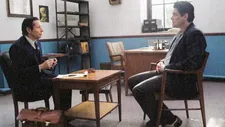 |
| Amalric as Devereux with Del Toro as Jimmy P: "there was a parallel between that maze and Jimmy's mind." |
AD: Yes. Actually to be that close to the book was never a trap because the book is so dry. It's an essay rather than fiction, so to make lines that are quite dull into living material is like a dance with human flaws. I love the idea that one guy is coming from Browning, Montana, the other guy is coming from Brooklyn, New York and they meet in Topeka. There are these other small challenges, just to be far from home. And to be in Topeka, Kansas which is nothing, the most boring place in the world. And strangely enough, that's where we happen to have the largest psychiatric hospital in the world because [Dr.Karl Augustus] Menninger was from Topeka. The army asked Menninger to train nurses and doctors and shrinks and psychiatrists for the army because they needed them during the war. So they asked Menninger who was a very important figure in the psychoanalytical world and he created a hospital with his brother. That's why all those people from Europe came to Topeka where there was nothing to do but work.
AKT: Blowing air into the spine as a medical procedure for Jimmy is that the actual procedure that was done to him? The way you were filming, the brown liquid on the spine doubles the brown color from the painting he was doing earlier. Please talk about this practice.
AD: The drawing with the finger, yes. It's so bizarre. You have to prove that Jimmy is cured. The truth means there is nothing to see. In the opening scenes, Jimmy arrives with the x-rays of his skull. The psychiatrists see that he didn't have a skull fracture. In fact, he had nothing. After that there is only one way - to have an image of the soul of someone. And it's actually not possible, but it's always tempting to see so I wanted to shoot this procedure. I wanted to show the procedure, the material things you have to do to get an image of the brain which is quite impressive, close to [David] Cronenberg and that kind of movie. Quite spooky and frightening.
AKT: You film the vast hospital as a maze. Finding your way in the hospital is like finding your way in somebody's brain.
AD: Yes, there was a parallel between that maze and Jimmy's mind. There is a scene when he is stepping outside… He is confused and he is in the fog. Once again, one foot in reality, documentary style, and one foot in the fairy tale aspect of it. You know, the guy is lost so I'm filming him in the mist. It's to find a very simple way to express to the audience.
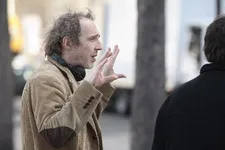 |
| Arnaud Desplechin on the set: "I love when Jimmy is looking at Lincoln looking at the grave." |
AKT: I am trying to connect your theory of becoming a man or a woman [which we discussed in part 1 of our conversation] in cinema to other films and to Jimmy P.
AD: I love when Jimmy is looking at Lincoln [He and Devereux go to the movies and watch Henry Fonda in Young Mr.Lincoln, 1939] looking at the grave. And he is looking at the President of the United States and he is thinking 'that's exactly me, I've been through that. I know everything about that mourning. I'm a widower.' That's a Thomas Hardy kind of feeling. I'm Jude the Obscure! That kind of character. You are cursed. I let this young girl die in the frozen river. I disrespect my mother. That's why I haven't been able to be a man and that's why I am a man.
AKT: The man is man because of the impotency of not being able to save and the woman is woman for the action of killing? The woman's part in this is active and the male's is passive.
AD: Exactly, yes.
AKT: You mentioned that The Hanging Tree [directed by Delmer Daves in 1959] was made chronologically too late for you to include. Maria Schell as a woman going blind and Gary Cooper caring for her would have given a very different idea than the clip from Lincoln.
AD: Yes, he is a widower on speed. Gary Cooper as a widower whose wife he did let die and now he has to stop the death of Maria Schell. In the end, the long monologue under the tree, that's the scene that allured me. I saw the film many years ago and never saw it again.
AKT: Was there another runner-up widower film besides Young Mr. Lincoln and The Hanging Tree?
AD: Kent [Jones] was positive about that. He said Lincoln is the best choice.
AKT: There is a scene at the tailors where Mathieu is trying on hats.
AD: When they talk about the labia of the wives?
AKT: Excuse me? What are you talking about?
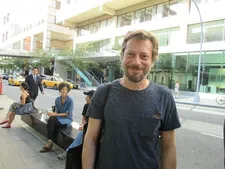 |
| Mathieu Amalric: "I am the witness." Photo: Anne-Katrin Titze |
AD: The scene at the tailors starts with Mathieu saying "Have you ever heard of this Blackfoot practice where the women have such long labia?"
AKT: I completely cut the scene in two in my head and censored the dialogue.
AD: The first part of the scene is about the labia and the second part is about this letter Menninger gets from the French which was sent to the American Psychoanalytical Association dismissing Devereux as a psychoanalyst.
AKT: The second part of this two-part scene is what I remember. What a fittingly Freudian omission. How embarrassing. I would never have asked you about that scene. Let's move on. "Any children? Not exactly." is good dialogue.
AD: That's from Kings and Queen. There are a lot of rhymes between these two films. I already shot that dialogue in French with Catherine Deneuve and Mathieu Amalric. I had to do it again. It's a line that I love. So I could film it again with different actors.
AKT: I'll look out for it in your future projects. Any other lines you recycle?
AD: No, no. Only this one.





















